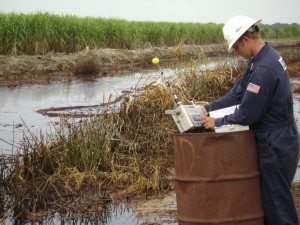By Mandy Sunderland, Sr. Industrial Hygienist, Total Safety

One of the biggest challenges facing safety and health practitioners today is ensuring that their companies operate in “proactive,” rather than “reactive,” mode. In reactive mode, an injury occurs, and an investigation is conducted to find out what happened and who to blame. Recommendations are made to address the specific incident, and corrective actions are often taken without understanding or addressing underlying system causes. This is an expensive way to operate, since corrective actions are initiated only after incidents have occurred.
Emergency response, by its nature, is reactive. Early in a response, immediate action is often required in the face of unknowns and uncertainties. The goal in an emergency is to shift from reactive response to systematic management of the incident. Advanced planning addresses a wide range of scenarios, identifies resources, training and drills. It will ensure that the equipment and resources can be obtained as quickly as possible, personnel are prepared with drills and training, and that additional staffing requirements are identified and contracted in advance so that the response effort is less frantic and more systematic.
Complacency also leads to being reactive. Well designed exposure monitoring plans fall out of date and are not refreshed. Recommendations from exposure surveys or incident investigations are not closed out and, over time, possibly forgotten. New employees don’t receive adequate training not only on equipment, but on risks and protective measures. Experienced workers take shortcuts and develop bad habits, which become normalized as “how we get it done here.” Operating processes change and new exposure hazards that are introduced to the workplace are not recognized and addressed. Failure to recognize these gaps and take proactive steps to refresh plans, knowledge, skills and training, leaves little choice but to operate in a reactive mode.
Leading an organization to a proactive approach
The ultimate goal of industrial hygiene (IH) professionals is to successfully guide their organizations into operating in a proactive made, but that’s not always easy to do. One of the biggest obstacles is the lack of knowledge and understanding by management of the risk associated with operations, and the appropriate steps needed to mitigate these risks. Given a full understanding of risks and consequences, most managers will make good, proactive business decisions to prevent incidents.
In a proactive mode, IH professionals devote their time and energy into understanding hazards and risks, and taking actions to prevent injuries and exposures. Potential exposures should be analyzed to determine risk and identify which controls can be used to prevent incidents. Resulting recommendations related to corrective actions and system improvements should be implemented prior to an injury or illness occurring. In a proactive mode, all incidents are considered preventable, as opposed to being random and unavoidable.
Getting the biggest bang for your IH monitoring bucks
All too often, facility management has fallen back on the same old IH sampling plan year after year. A facility without a clearly thought out, up-to-date plan to assess their workplace exposures, may sample unnecessary materials, bringing with it a false sense of security. This can occur when changes in operations, processes or materials are not recognized and evaluated. Monitoring the wrong exposures increases cost and decreases true exposure knowledge. In addition, it may become difficult to maintain compliance with regulatory standards, including ACGIH and OSHA regulations.
Sometimes a facility will opt to require respirators or personal protective equipment (PPE) to reduce or control worker exposures. These types of measures far too often become a permanent control measure, but, in the long run, are expensive and difficult to maintain. Often an experienced industrial hygienist can suggest permanent simple fixes that are inexpensive and easy to maintain.
Furthermore, other programs that depend on the results of your IH monitoring, such as medical surveillance, hazard communication, respiratory protection and PPE, and exposure control (ventilation) programs, may also suffer.
Including IH in your turnaround planning
During a typical plant turnaround, a large number of people work together to repair and recharge complex equipment against a tight schedule and budget. Turnarounds require a high degree of planning, scheduling and coordination, so that the right combination of equipment and personnel are available when needed.
Many turnaround plans focus on mechanical and maintenance aspects and neglect to include critical support services that help to keep activities on schedule. These support items may include safety training and management, industrial hygiene monitoring, lead and asbestos testing, perimeter monitoring and environmental monitoring. Inadequate planning for HSE support can cause unanticipated delays, resulting in increased cost, anxiety and setbacks.
Turnarounds often present significant exposure potential to hazardous chemicals not encountered during normal operations. When normally closed vessels are opened up, bundles and exchangers may be pulled, and catalysts replaced. As these jobs are not routine, sometimes only inexperienced workers are available, who require more training and supervision that are potential costs and delays of the critical path.
Protecting your employees’ hearing
High noise levels on the job can result in hearing loss, as well as physical and psychological stress in the workforce. Excessive noise exposures also take a bite out employers’ pocketbooks, as they financially compensate workers. If worker exposure data and audiometric test records are not well managed and maintained, it can be difficult to make connections between exposures and symptoms of hearing loss. It is always preferable to reduce noise at the source through engineering controls, but lack of a “comprehensive hearing conservation program,” as required by OSHA, can make it difficult to analyze and implement appropriate controls.
Protecting your employees from NORM
Exposure to radiation can result from natural sources, such as Naturally Occurring Radioactive Materials (NORM), and not just from industrial equipment, such as material level and thickness gauges, testing equipment that contain radioactive isotopes or X-ray inspection devices, and electron microscopes.
Certain industrial processes tend to concentrate NORM and bring workers into situations of more direct or prolonged exposure and increase risk from ingestion, inhalation or absorption of radioactive materials. In the oil and gas business, NORM often flows to the surface as a by-product of oil and gas production and concentrates as scale, sands and sludge on production strings, flowlines, pipelines and production equipment.
NORM materials may then be encountered during routine maintenance, refurbishment activities and replacement operations. Disposal, reuse and recycling of NORM can cause occupational exposures as well. Improper handling and maintenance of industrial radiation sources can also lead to elevated exposures. Health effects from exposure to radiation may occur shortly after exposure or may be delayed for months or even years, which can make it difficult to track.
Ensuring health protection during an emergency
Natural and man-made disasters present costly challenges for industry today. A large scale disaster can disrupt or shut down business operations, cause physical or environmental damage and release hazardous materials that threaten the health of employees and the public.
Lack of proactive IH sampling plans during emergencies for exposures, both inside and outside the fence, can result in workforce and public anxiety and increase potential liability and unwanted media attention. Failure to communicate a clear understanding of what happened, what the potential exposures are, related exposure standards and potential health effects can destroy credibility.
With all the challenges that we face as leaders in the HSE field, we understand the importance of focusing energy on key issues in the workplace today and taking steps toward working in the proactive mode as regular operating practice. Once accomplished, we can provide leadership and direction to the workplace, bring vitality to the practice of IH, facilitate industry to adapt to ever challenging situations and save money!








